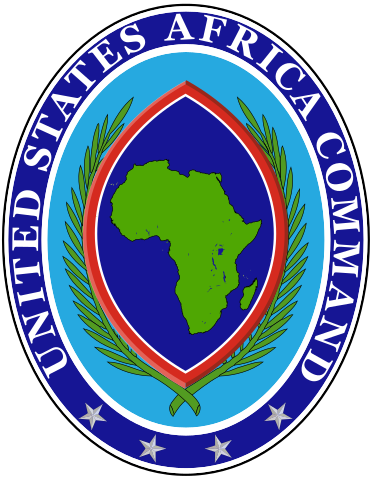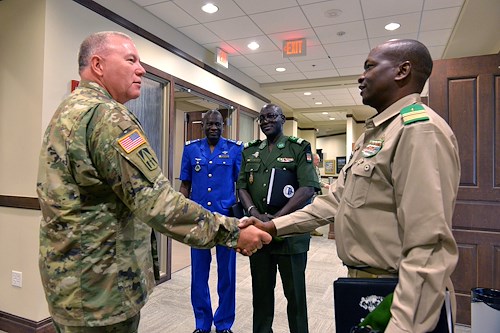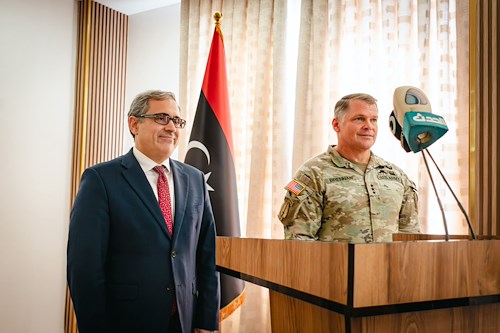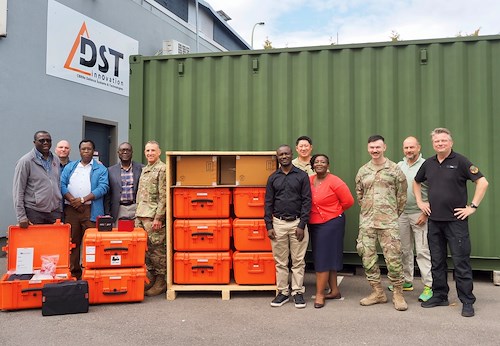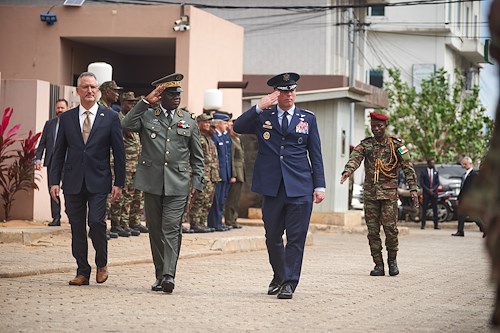ARLINGTON, Va. – In some ways, the National Guard Bureau's State Partnership Program – which pairs National Guard elements with partner nations worldwide – started with a tuba.
"The Latvian military band needed a big tuba," said retired Air Force Maj. Gen. John Conaway, the 22nd chief of the NGB and "father" of the SPP. "And we hauled a tuba over there."
The trip with the tuba was part of the early planning stages for the program, which turns 25 this year.
"We delivered that tuba to the Latvian band and they were amazed to get it," said Conaway. "That started the program with the first, initial visit."
That first visit lead the way to a program that now has 74 partnerships with countries throughout the world. But it all started with three: Latvia, Lithuania and Estonia.
"We were received in grand fashion in all three places," said Conaway, referring to that initial trip. Where it would go from there, he added, was then still unknown.
"We didn't know what was going to happen," he said. "But, we had the visit. That was the start."
That first visit was the result of a simple directive from Army Gen. John Shalikashvili, then-supreme allied commander in Europe with NATO, and who would be appointed chairman of the Joint Chiefs of Staff in 1993.
"He called me up and said "we've got to help these new emerging democracies [in the Baltics],'" said Conaway, adding that after additional planning with Pentagon officials, he formed a small team and they started working with the State Department. That led to meeting with the presidents of Latvia, Lithuania and Estonia, as well as military officials in those countries.
"It looked like they wanted our help and we started talking about putting liaison officers from the National Guard on orders with them," said Conaway. "Our role was to help make the transition [to democracy] as smooth as we could."
The idea of liaison officers grew into tying specific Guard elements with specific countries.
"The [team] and I huddled and thought, "We've got tons of Lithuanians and Lithuanian-Americans living in Pennsylvania,'" Conaway said. "It fit. We'll tie Lithuania to the Pennsylvania National Guard."
The idea grew from there.
"There were a lot of Latvian-Americans in Michigan, so we got with the adjutant general [of the Michigan National Guard] and tied them together with Latvia," said Conaway. "There are Estonian-Americans in Baltimore, and so we tied [Estonia] together with the Maryland National Guard."
Conaway added there was little precedent to follow while developing the program.
"We were doing this off the back of an envelope back then," he said. "It was happening so fast."
By the time Conaway retired in November 1993, the SPP had 13 partnerships, primarily with former Eastern Bloc countries in Europe.
The following years saw new partnerships added from across the globe.
"It's grown to 74 partnerships and that's been an incremental growth of about two to three partnerships a year," said Air Force Col. Donald McGuire, chief of the international affairs branch at the NGB.
As the program has expanded, the process for adding new partnerships has become more refined.
First, the country has to request to be a member of the program, said McGuire, adding that input from the State Department and the combatant command – the U.S. military command element overseeing specific geographic regions – goes along with that request.
"They collectively decide that this is a good country we want to nominate for selection into the program," said McGuire, adding that from there staff work is done to determine the best course of action with pairing up elements for a partnership.
"It's very analytical what the staff here does," said McGuire. "They put a lot of hard work and brain cells against making sure they're doing a good analysis to give the chief [of the NGB] the best recommendation they can."
The long-term success of the program has come about, in part, from that intrinsic relationship with both the State Department and the combatant command, said McGuire. The SPP is nested with the command's theater security cooperation plan and the State Department's country study plan.
"It's in tune with the combatant commanders, therefore, it's in tune or synchronized with the National Defense Strategy," McGuire said.
Building relationships, said McGuire, is one of the hallmarks of the program.
"This provides, perhaps, the most well-known and established international partnership capability the National Guard is involved with," he said. "These are relationships that have grown over the course of time and continue to grow."
Those relationships have not only seen partners in the program train together, but also work together in the wake of natural disasters and large-scale emergencies.
It's also seen co-deployments to Iraq, Afghanistan and other areas.
"You wouldn't have these countries and units deploying together, necessarily, if they didn't already have this relationship."
McGuire added that's a significant element.
"That tells you a lot about the program," he said. "These co-deployments are real-world operations, named contingencies that represent the next level of collaboration and coordination."
Building collaboration and coordination is also key to building greater regional security, said Army Brig. Gen. Christopher F. Lawson, the NGB's vice director of strategy, policy, plans and international affairs.
"In order to promote greater peace and stability in the world long into the future, we will need a program like the SPP because it helps nations transition from security consumers to security providers," he said.
For Conaway, the continued growth of the program is more than he imagined 25 years ago.
"It is beyond my wildest dreams and imagination that it would be this passionate and this popular and the good the National Guard has done," he said. "Here we are, 25 years after it started and the National Guard is just as enthusiastic as ever."
The pairing of the West Virginia National Guard with Qatar was announced in April and McGuire said additional partnerships are in the coordination phase.
"We have a few more partnerships in the queue," he said, adding he sees continued growth of the program over the next 25 years and beyond.
"It really is the entry point to a lot of good things that happen," McGuire said.
